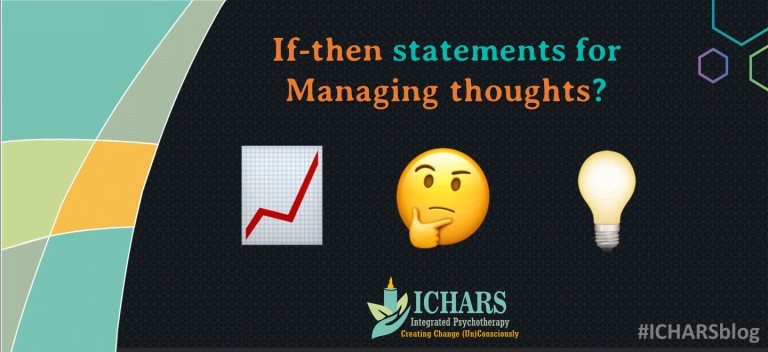In an earlier post we had described, how our behaviours are generally driven by our internal story and that we can influence our behaviour and the behaviours of others by changing these story.
In this post we will shift our focus to a simple yet powerful technique, known as the “If-Then Statements”, that can be used for reprogramming mind and behaviours by changing the internal story.
Understanding If-then Statements
I’m sure you have heard of this expression If – then before, haven’t you?
It is a very common expression in computer programming. Simply speaking with “if-then statements” we are telling the system “if A happens then the system is supposed to do B”.
For example, if A is “double click on a .doc file”, and B is “Open Microsoft word and display the contents of the file”.
So, whenever someone double clicks a .doc file the system will automatically open Microsoft word and display the contents of the file.
If-then Statements and Human behaviour
Now that you understand what if-then statements do, you may wonder how is it related to changing human behaviour?
It is quite simple because the human system when it comes to automatic behaviours is not too different from a computer system.
It works consistently and systematically once an if-then program has been accepted.
If becomes the stimulus and then becomes the response.
For example, have you ever come across a person who has had a phobia of cockroaches? Has it ever happened that one day he/she sees a cockroach and forgets that he/she has a phobia?
No right!
Every time without fail whenever he/she sees a cockroach, he/she looks at it and behaves in a consistent manner. Like, he/she jumps, shrieks, shouts and finally runs out of the room. He/she would never fail to do that.
It is almost like a program running on autopilot, is it not?
A program that has resulted in a strong association that is undesirable.
Take another example of Stage and Anxiety. Someone who is anxious of public speaking would generally find it difficult to break this association. Every time they see a stage or a large audience, the mind automatically runs a program that creates anxiety.
Reprogram mind and behaviour with If-then statements

But what if we could use “If-Then Statements” to literally suggest the mind to run a new program instead of the old one.
What if we would use the “If-Then Statements” to break the old association and create a new one?
Think of it as a new program that is being installed which follows the rule “If A then C”
Which means the next time, when the person sees a stage his mind automatically runs a program that creates confidence and excitement.
It would be amazing, wouldn’t it be?
But can If-then statements really do this?
The short answer is YES!!! The long answer, if you follow the process of using if-then statements correctly and combine it with the power of repetition, it is quite incredible as to what these two can help you accomplish.
What do I mean by the right process when using “If-Then Statements”?
Take the stage and anxiety example: Even if a person continuously repeats to himself “If I see a stage, then I feel confident” would the repetition really work?
The chances are very less because it is a big jump and the mind may not know how to make this jump. In other words, the mind is not aware of the program that can create this new feeling.
So, we need to create a slightly smaller jump that contains the details about the program that the mind can run to create this feeling. Once the mind runs the program, the feeling will come naturally.
But what will this new program be?
We already know from the “why we do what we do post” that the external stimulus triggers a story in the mind and it is this story that leads to the behaviour. The existing program is the current undesirable story and the new program will be a new desirable story.
Reprogramming mind and behaviour with If-then statements: Examples
- So, going back to the Stage and Anxiety example.If the current story is “people throwing tomatoes at him”, obviously he feels anxious. But what if the new story is, “audience giving him a standing ovation or that he has the potential to transform lives”?
Wouldn’t the new story generally create more desirable emotions and responses?
- So, if the current scenario is:“If I look at my partners’ face, then I feel angry”.I now know that it’s not the partner’s face that is making me angry, but that in my head a story is playing about probably all the times he has misunderstood me. What if we change this story to about all the good things he has done for me.
Would the new story influence the way I feel?Yes, at least to some extent if not completely.
- One area where If-then statements have been used extensively is sports psychology. So, let us take a couple of examples from there:
- Let’s take an example of a cricketer, a batsman, who is afraid of tall bowlers. The current story his mind creates is that “the tall bowler will be super-fast and that he will get hurt.” But What if on seeing the tall bowler the 1st thought in his mind is “that height is not equal to speed.”Wouldn’t this new thought/story be useful in making the batsman feel more comfortable?
- Another example is of a basketball player, who gets blanked out when he sees players of opposing team crowding him. What if instead of getting blanked out the automatic thought running in his mind is “look for the nearest teammate and pass the ball.”Wouldn’t this thought be more useful for the player?
How do we use If-Then Statements to connect the stimulus with a new story i.e. to reprogram the mind and behaviour?
We connect the two together simply by the power of rhythmic repetition.
Have you heard of the chant “Hare Rama, Hare Krishna?
If have come across this chant a no. of times, you may have noticed that even without believing in it, if you hear “Hare Rama”, the first thing that comes to your mind is Hare Krishna.
Why?
Because you have heard this n number of times and the repetition has created an association.
So there are 2 things at play here: First is repetition and second is that the chant is very rhythmic.
With the If then statements, that’s exactly what we will be doing. We will be repeating a rhythmic expression in the form of If this – then this to create an association that is strong enough to work on autopilot.
So, taking each of the examples from the above, the expressions that the person needs to repeat are:
- If I see a stage, then I realise my potential to create a change
- If I look at my partners face, then I remember all the good things he has done for me. (We can even elaborate on the good things that the partner does)
- If I see a tall bowler, then I realise Height is not equal to speed
- If I see players of opposing team crowding me, then I find the nearest team member and pass the bowl.
Now that you understand how the new if-then statements would look and sound like, let us list the steps to create and use these statements.
Steps to create and use IF-Then statements
- Identify the stimulus.
- Identify the current story that is leading to the current response. This step is optional but can be useful especially for the next step
- Identify the new story that will trigger the new response naturally.
- Create an if then statement using the format If Stimuli – then New Story. Refer to earlier examples for clarity.
- Repeat the new “if-then statement” as many times as you can everyday till you reach a point where even in a half sleepy state if someone says if followed by the stimulus, the new story should automatically come to your mind.
A couple of things you should keep in mind:
- Generally, if you repeat the if-then statement as many times as possible whenever you have time like while travelling, watching T.V., waiting in a restaurant, standing in a que you will begin to notice an observable difference within a week.
- If then statements may not work in situations involving intense negative emotions. There are other techniques that we will share for the same from a therapist’s point of view.
- If you have a situation that triggers intense negative emotion, we would recommend that please visit a therapist to help you with the same.
- The effectiveness of If-then statement for reprogramming mind and behaviour increases multiple times when it is used in conjunction with Hypnosis.
Before going ahead, why don’t you give this technique a try?
Take any one situation / issue / habit from your life and use this technique?
If you are a coach or a trainer who would like to learn to use “If-Then statements” with your clients or participants along with other advanced coaching techniques, you would really appreciated our power packed and comprehensive Cognitive Hypnotic Coaching™ Program. On the other hand if you are a psychologist or have completed your MSW, you must search for the Cognitive Hypnotic Psychotherapy™ Program.

